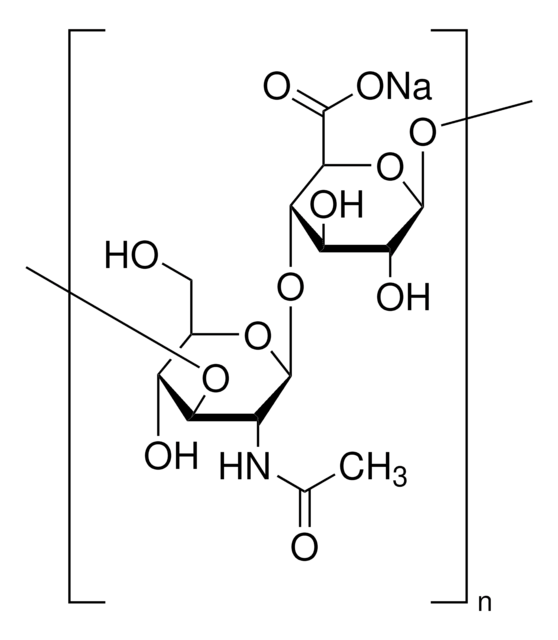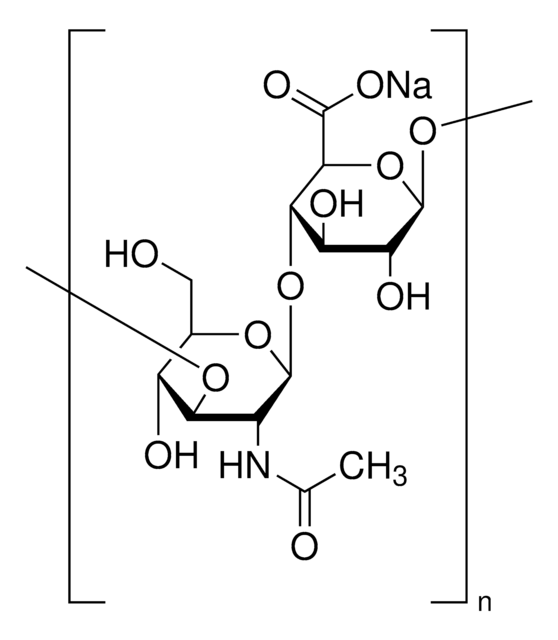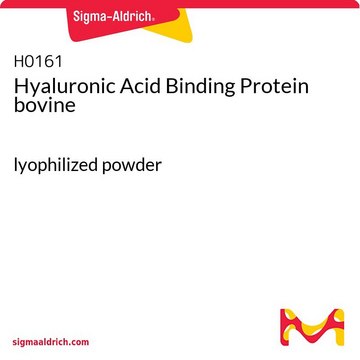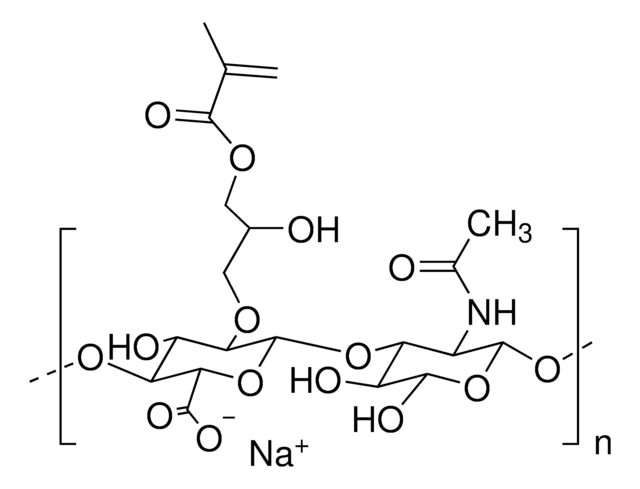924474
Hyaluronic Acid
Low Viscosity, Low endotoxin
Synonym(s):
3D bioprinting, HA, Hyaluronan
Sign Into View Organizational & Contract Pricing
All Photos(1)
About This Item
UNSPSC Code:
12352201
NACRES:
NA.23
Recommended Products
Quality Level
form
(powder or chunk(s) or fibers)
impurities
<10 CFU/g Bioburden
<100 EU/g Endotoxin
color
white to off-white
suitability
conforms to structure for NMR
storage temp.
2-8°C
General description
Hyaluronic acid (HA) is a linear polysaccharide of alternating D-glucuronic acid, and N-acetyl-D-glucosamine found in the extracellular matrix. HA is commonly chemically modified to form covalently crosslinked hydrogels. Other properties of HA include cell surface receptors CD44 and RHAMM recognition and degradation via hyaluronidases.
Application
HA is increasingly used for the following biomedical applications:
Our low endotoxin HA is tested for both endotoxin (< 100 EU/g) and bioburden (< 10 CFU/g) levels, so you can choose which material is right for your research.
- Cell migration
- Angiogenesis
- Viability
- Proliferation
Our low endotoxin HA is tested for both endotoxin (< 100 EU/g) and bioburden (< 10 CFU/g) levels, so you can choose which material is right for your research.
Storage Class Code
11 - Combustible Solids
WGK
WGK 3
Flash Point(F)
Not applicable
Flash Point(C)
Not applicable
Choose from one of the most recent versions:
Certificates of Analysis (COA)
Lot/Batch Number
Sorry, we don't have COAs for this product available online at this time.
If you need assistance, please contact Customer Support.
Already Own This Product?
Find documentation for the products that you have recently purchased in the Document Library.
Tracey J Brown
Current pharmaceutical biotechnology, 9(4), 253-260 (2008-08-12)
Despite advances in chemotherapeutic regimens, the treatment of metastatic cancer remains a challenge. A key problem with chemotherapy drugs is nonspecific drug distribution, resulting in low tumor concentrations and systemic toxicity. The holy grail of clinical cancer research has been
Federica Camin et al.
Journal of agricultural and food chemistry, 58(1), 570-577 (2009-12-17)
H, C, and O stable isotope ratios and the elemental profile of 267 olive oils and 314 surface waters collected from 8 European sites are presented and discussed. The aim of the study was to investigate if olive oils produced
Xian Xu et al.
Soft matter, 8(12), 3280-3294 (2012-03-16)
Hyaluronic acid (HA) is one of nature's most versatile and fascinating macromolecules. Being an essential component of the natural extracellular matrix (ECM), HA plays an important role in a variety of biological processes. Inherently biocompatible, biodegradable and non-immunogenic, HA is
Kevin T Dicker et al.
Acta biomaterialia, 10(4), 1558-1570 (2013-12-24)
Hyaluronan (HA) is a linear polysaccharide with disaccharide repeats of d-glucuronic acid and N-acetyl-d-glucosamine. It is evolutionarily conserved and abundantly expressed in the extracellular matrix (ECM), on the cell surface and even inside cells. Being a simple polysaccharide, HA exhibits
Our team of scientists has experience in all areas of research including Life Science, Material Science, Chemical Synthesis, Chromatography, Analytical and many others.
Contact Technical Service





